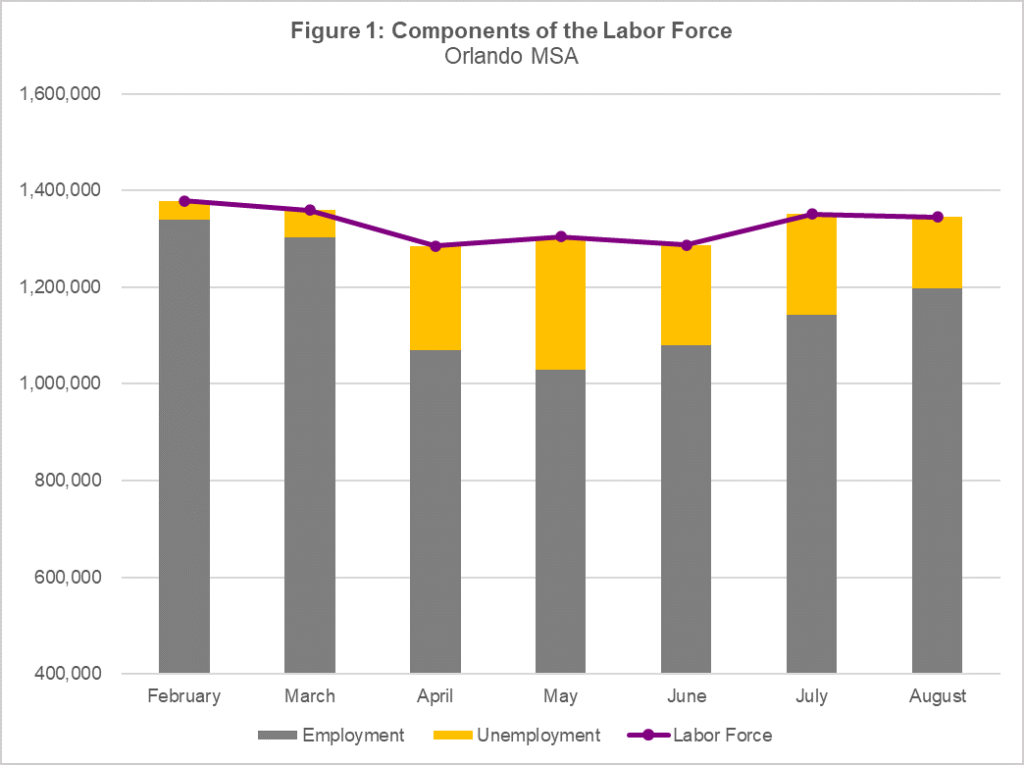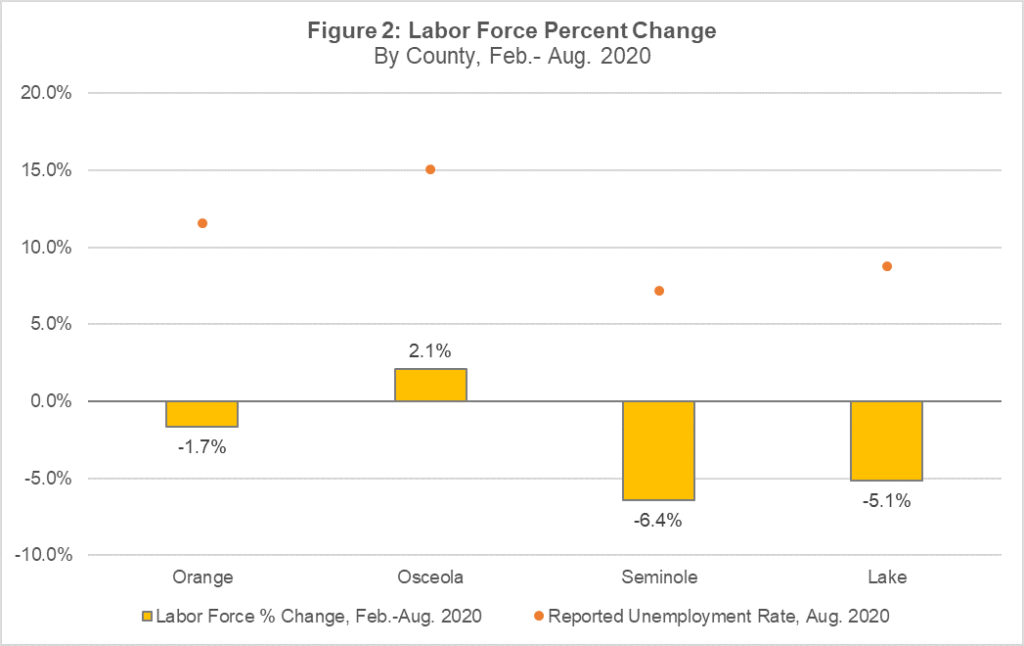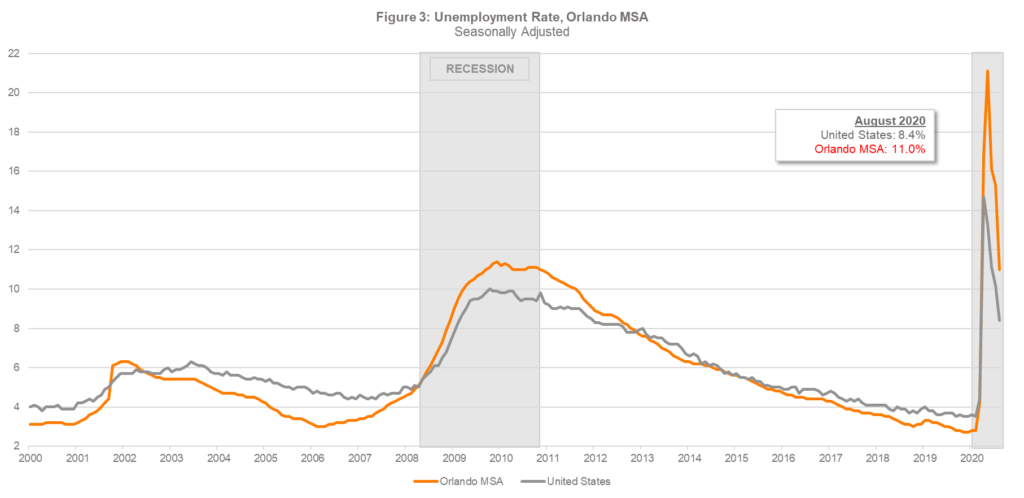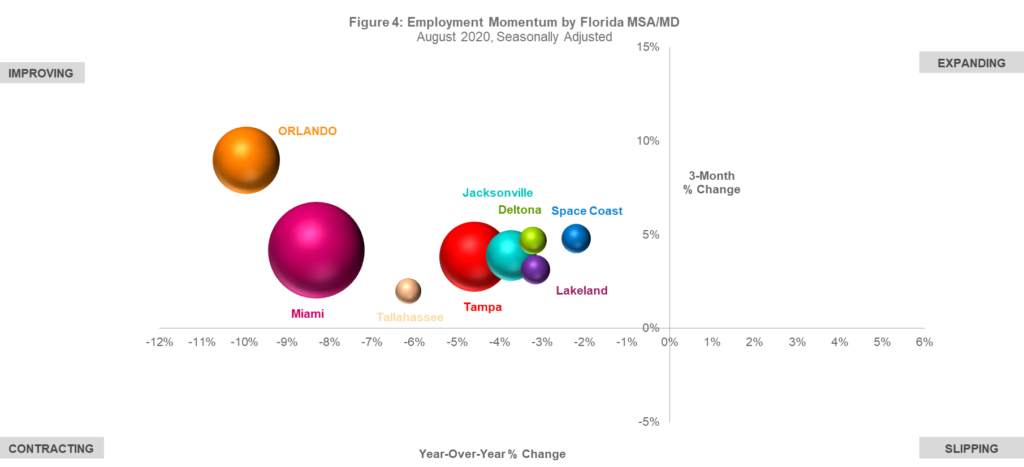Co-authored by José Rivera – Associate Director, Business Development
This week’s economic update analyzes leading indicators and key takeaways from COVID-19 impacts put into historical context over the last 20 years, with the August job report fueling much of this analysis.
This week the Partnership research team analyzed data from the August job report to inform takeaways in both a broader, historical context (viewed in the Orlando MSA Market Overview), and the more immediate impacts to Orlando’s economic recovery (viewed in the weekly, high frequency indicators analysis).
August Jobs Report
The job report released by the Florida Department of Economic Opportunity on September 18 included unemployment and industry employment data for the month of August. This month we focus analysis on changes to the labor force and what that implies for changes in the unemployment rate and potential population shifts.
Important Definitions: The labor force is made up of both employed and unemployed individuals. The unemployment rate is the percentage of the labor force counted as unemployed. To be counted as unemployed, a person would need to both: not have a job and have made some effort to find a job in the previous four weeks. This definition means that individuals who stop looking for work after a month are removed from the labor force and not counted in the unemployment rate. Read more about how these measures are calculated here. This dynamic is one to watch because it reveals levels of discouragement in the job market as people drop out of the labor force altogether.
The Orlando Metropolitan Statistical Area (MSA) labor force fell by roughly 5,800 individuals from July to August. Employment levels rose by 54,500 and unemployment fell by 60,300, resulting in a regional unemployment rate of 11.0 percent for August. See Figure 1 below. The current labor force is below February 2020 levels by two percent, suggesting there are individuals not being counted in the current unemployment rate.

The individual counties making up the Orlando MSA exhibit differing dynamics. Orange County’s labor force is 1.7 percent smaller. Meanwhile, Seminole and Lake Counties have seen a 6.4 and 5.1 percent reduction in their labor force since February 2020, suggesting that unemployment may be higher than the 7.2 and 8.8 percent rates reported for August.
Osceola County, on the other hand, has experienced an increase in the labor force since February. The number of employed persons in Osceola County is below pre-pandemic levels, but the number of unemployed persons has increased drastically, beyond the drop in County employment. This could mean that Osceola County’s unemployment rate, 15.1 percent (currently the highest in the State), is overstated. See Figure 2 below.

Market Impacts in Broader Context
This monthly job data contributes to a fuller picture of Orlando’s job losses so far in 2020, and the sheer scale of employment losses in a historical context. For example: since 2015, the Orlando MSA had an unemployment rate consistently under 6.0 percent and below the national average. During the immediate impact of the pandemic, unemployment in the Orlando metro peaked at more than 20 percent, well above the United States peak. See Figure 3 below.

Other indicators such as the Orlando retail index, which measures consumer spending and personal consumption, have fallen to levels closer to 2012. Year to date, all categories of taxable sales have decreased except for building investment. Meanwhile, the office space vacancy rate has increased to levels similar to 2016, while average rental rates continue to increase. The industrial vacancy rate has also increased to levels closer to 2015.
This historical data does, however, show signs of bettering employment outcomes over the last three months. While every major metro in Florida (and the U.S.) is experiencing year-over-year job losses, job gains from the past three months continue. See Figure 4 below.

From July to August, Orlando added 14,400 jobs back to the region, mainly in government work. In the previous month, the region added back over 56,000 jobs, more than Orlando typically sees in an entire year’s worth of job gains.
Explore this context and more in the Orlando MSA Market Overview, the first to include data on broader impacts from COVID-19.
Leading Indicators
Employment momentum appeared in other metrics as well when analyzing select high frequency indicators for signs of economic recovery.
New claims for unemployment insurance continue to decrease in Florida while the U.S. reported a plateau. The number of U.S. claims is plateauing in the 880,000’s for the fourth consecutive week. In Florida, claims continue to decrease, but at a slower rate. Florida reported 35,829 new weekly claims for unemployment insurance.
As of September 12, claims for unemployment in the Orlando MSA were also decreasing at a slower rate, with claims remaining in the 3,000’s for three consecutive weeks. The Orlando MSA reported 3,260 new weekly claims, the lowest since the start of the pandemic. Claims in all four counties (Orange, Osceola, Seminole and Lake) decreased.
Job posting data reflects real-time labor market information and business recovery. In the most recent week, job postings saw an increase of 34.6 percent. Healthcare and social assistance, retail trade and financial and insurance saw the largest increase in posting activity, driving this weekly bump. Employers in hospital and healthcare services, defense, and public schools continue to be the major job posters in the region. Note: Job posts do not measure hires and may include companies who continue to post jobs but are on a hiring freeze.
Historical data shows the true scope of COVID-19 impacts on the economy. The effects of COVID-19 shut-downs on employment and consumer spending were deeply felt. However, weekly indicators continue to show signs of improvement, as employment numbers climb out of the deep rut they fell into. The monthly jobs report informs both short and long-term views, and pointing to more volatile trends in labor market participation that should be closely monitored for signs of more lasting impacts.
For more information, view COVID-19 data in a historical context and the weekly indicators.
Co-authored by:

José Rivera Associate Director, Business Development
José is the Associate Director of Business Development at the Orlando Economic Partnership, focusing on developing the “Why Orlando” business case, and providing business intelligence and analytics to potential companies relocating or expanding in the Orlando metro. He studied Economics with a focus on Business Analytics at the University of Central Florida.





